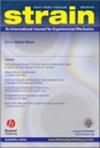Evolution of interphase stress over a crack propagation plane as a function of stress relief heat treatments in a PBF‐LB/M AlSi10Mg alloy
IF 2.1
3区 材料科学
Q2 Engineering
引用次数: 0
Abstract
In this study, we compare the residual stress state in a laser powder bed fusion (PBF‐LB/M) AlSi10Mg alloy in the as‐built (AB) condition with that after two different heat treatments (265 °C for 1 h, HT1; and 300 °C for 2 h, HT2). The bulk residual stress (RS) is determined using synchrotron X‐ray diffraction (SXRD), and near‐surface profiles are determined using laboratory energy‐dispersive X‐ray diffraction (EDXRD). The EDXRD results do not reveal any notable difference between the conditions at a depth of 350 μm, suggesting that the machining process yields a comparable residual stress state in the near‐surface regions. On the other hand, the SXRD results show that HT1 is more effective in relieving the bulk RS. It is observed that HT1 reduces the RS state in both the aluminium matrix and the silicon network. In addtion, HT2 does not have a significant impact on relaxing the RS as‐built state of the matrix, although it does induce a reduction in the RS magnitudes of the Si phase. It is concluded that the heat treatment stress relieving is effective as long as the Si‐network is not disaggregated.PBF-LB/M AlSi10Mg 合金中裂纹扩展面上相间应力的演变与应力消除热处理的关系
在本研究中,我们比较了激光粉末床熔化 (PBF-LB/M) AlSi10Mg 合金在坯料 (AB) 状态下与两种不同热处理(265 °C,1 小时,HT1;300 °C,2 小时,HT2)后的残余应力状态。利用同步辐射 X 射线衍射 (SXRD) 测定了整体残余应力 (RS),并利用实验室能量色散 X 射线衍射 (EDXRD) 测定了近表面轮廓。EDXRD 结果显示,在深度为 350 μm 的条件下,两者之间没有明显差异,这表明加工过程在近表面区域产生了相似的残余应力状态。另一方面,SXRD 结果表明,HT1 能更有效地缓解块体 RS。据观察,HT1 可降低铝基体和硅网络中的 RS 状态。此外,HT2 对松弛基体的 RS 原态没有显著影响,但确实导致硅相的 RS 量级降低。结论是,只要硅网络没有分解,热处理应力消除是有效的。
本文章由计算机程序翻译,如有差异,请以英文原文为准。
求助全文
约1分钟内获得全文
求助全文
来源期刊

Strain
MATERIALS SCIENCE, CHARACTERIZATION & TESTING-
CiteScore
4.50
自引率
4.80%
发文量
27
审稿时长
2.3 months
期刊介绍:
Strain is an international journal that contains contributions from leading-edge research on the measurement of the mechanical behaviour of structures and systems. Strain only accepts contributions with sufficient novelty in the design, implementation, and/or validation of experimental methodologies to characterize materials, structures, and systems; i.e. contributions that are limited to the application of established methodologies are outside of the scope of the journal. The journal includes papers from all engineering disciplines that deal with material behaviour and degradation under load, structural design and measurement techniques. Although the thrust of the journal is experimental, numerical simulations and validation are included in the coverage.
Strain welcomes papers that deal with novel work in the following areas:
experimental techniques
non-destructive evaluation techniques
numerical analysis, simulation and validation
residual stress measurement techniques
design of composite structures and components
impact behaviour of materials and structures
signal and image processing
transducer and sensor design
structural health monitoring
biomechanics
extreme environment
micro- and nano-scale testing method.
 求助内容:
求助内容: 应助结果提醒方式:
应助结果提醒方式:


